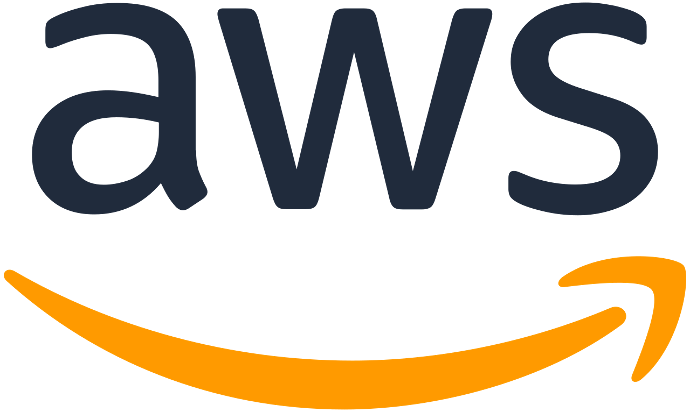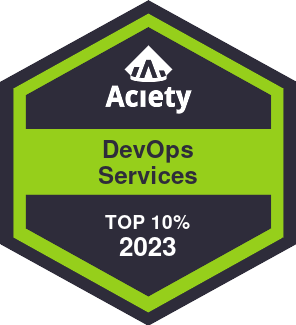DevOps as Service
DevOps-as-a-Service (DaaS) lets you take advantage of delegating all related tasks, management and system maintenance to the professional DevOps services company and its engineers, thus, opening the opportunity for developers to focus on the product improvements and delivering new features
Team's certifications and recognition
Our staff has proven expertise in the most comprehensive technologies.






How it works
Plan and measure
We are the leading firm in delivering quality and value. Our professionals have more than 5 years of experience
Develop and test
Our managers are always ready to answer your questions. You can call us on weekends and at night.
Release and deploy
Our company works according to the principle of individual approach to every client.
Monitor and optimize
We review your current monitoring systems and recommend changes and the adoption of best practices so you know what's wrong immediately and have the information needed to fix it.
What we offer
We support our clients across the following core pillars but not limited to
Dev Ops Support
DevOps assessment & audit
DevOps implementation from scratch - roadmapping and strategy design DevOps consulting
Release management
Cloud servises
Cloud readiness assessment
Cloud migration
Managed cloud services
Infrastructure architecture design
Microservices architecture design Microservices consulting. Content Delivery Network (CDN) design
Security
Infrastructure automation
Infrastructure as code implementation in a cloud
Infrastructure as code implementation on-prem
CI/CD
Continuous integration (CI) implementation Continuous delivery (CD) implementationCI/CD consulting
Create infrastructure as code (IAAC)
Infrastructure automation
Infrastructure as code implementation in a cloud
Infrastructure as code implementation on-prem
Container orchestration
Container orchestration
Container management services
Security evaluation and hardening
Kubernetes managed services
Log management and monitoring
Log management
Monitoring. Reporting
Alerting
About Dev Ops Services
Cloud infrastructure architecture design refers to the process of planning and implementing the infrastructure for a cloud computing environment. This includes designing the hardware, software, networking, and other components needed to support the deployment and operation of applications and services on the cloud.
In cloud infrastructure architecture design, it is important to consider factors such as the desired level of scalability, performance, security, and cost-effectiveness, as well as the specific requirements of the applications and services being deployed on the cloud.
The design process typically involves selecting the appropriate cloud computing model (such as public, private, or hybrid cloud), as well as the underlying infrastructure components and technologies to be used (such as virtual machines, containers, storage systems, and networking configurations).
There are various instruments and tools that can be used to support the cloud infrastructure architecture design process, including:
● Cloud architecture frameworks: These provide a set of guidelines and best practices for designing and implementing cloud infrastructure architectures. Examples include the AWS Well-Architected Framework and the Cloud Native Computing Foundation's (CNCF) Cloud Native Landscape.
● Cloud infrastructure automation tools: These enable the automatic provisioning and management of cloud infrastructure resources, such as virtual machines, storage systems, and networking configurations. Examples include Terraform, CloudFormation, and Ansible.
● Cloud infrastructure monitoring and management tools: These allow organizations to monitor and manage the performance and availability of their cloud infrastructure resources. Examples include CloudWatch, New Relic, and Datadog.
● Cloud security tools: These help organizations secure their cloud infrastructure and protect against threats such as data breaches and cyber attacks. Examples include CloudTrail, CloudHSM, and AWS Shield.
Infrastructure management refers to the process of planning, organizing, and controlling the operations and maintenance of an organization's infrastructure. This includes the hardware, software, networking, and other components that support the deployment and operation of applications and services.
There are various instruments and tools that can be used to support infrastructure management, including:
● Configuration management tools: These allow organizations to automate the process of deploying, configuring, and managing infrastructure resources. Examples include Ansible, Terraform, Helm
● Monitoring and management tools: These enable organizations to monitor the performance and availability of their infrastructure resources, and take corrective action if necessary. Examples include CloudWatch, New Relic, and Datadog.
● Service desk and incident management tools: These allow organizations to manage and track incidents and issues that arise in their infrastructure, and to resolve them in a timely and efficient manner. Examples include ServiceNow or PagerDuty.
● Change management tools: These enable organizations to track and control changes to their infrastructure, ensuring that they are implemented in a controlled and consistent manner. Examples include JIRA and ServiceNow.
Operational management refers to the process of managing the day-to-day activities and processes that are necessary for an organization to function effectively. This includes activities such as planning and scheduling work, coordinating resources, monitoring performance, and controlling costs.
There are various instruments and tools that can be used to support operational management, including:
● Project management tools: These allow organizations to plan, track, and manage projects, including setting goals, defining tasks, and allocating resources. Examples include Jira, Trello, and Microsoft Project.
● Collaboration and communication tools: These enable teams to communicate and collaborate effectively, regardless of location. Examples include Slack, Microsoft Teams, and Zoom.
● Resource scheduling and planning tools: These help organizations schedule and plan the use of resources such as staff, equipment, and facilities. Examples include Google Calendar, MS Outlook.
● Performance monitoring and management tools: These allow organizations to track and monitor the performance of their operations, and identify areas for improvement. Examples include Datadog, New Relic, and CloudWatch.
Infrastructure monitoring refers to the process of continuously monitoring the performance and availability of an organization's infrastructure. This includes the hardware, software, networking, and other components that support the deployment and operation of applications and services.
There are various instruments and tools that can be used to support infrastructure monitoring, including:
● Network monitoring tools: These allow organizations to monitor the performance and availability of their network infrastructure, including routers, switches, and other networking devices. Examples include Nagios, and Zabbix.
● Server monitoring tools: These enable organizations to monitor the performance and availability of their servers, including CPU utilization, memory usage, and disk space. Examples include Datadog, New Relic, and CloudWatch.
● Application performance monitoring (APM) tools: These help organizations monitor the performance of their applications, including response times, error rates, and other metrics. Examples include New Relic, AppDynamics, and Dynatrace.
● Storage monitoring tools: These allow organizations to monitor the performance and availability of their storage systems, including disk space, I/O performance, and other metrics. Examples include CloudWatch, Datadog, and Splunk.
● Database monitoring tools: These enable organizations to monitor the performance and availability of their databases, including query response times, CPU utilization, and other metrics. Examples include Datadog, New Relic, and CloudWatch.
Incident management refers to the process of identifying, triaging, and resolving incidents that occur in an organization's infrastructure. An incident is an event that disrupts or threatens to disrupt the normal operation of the infrastructure.
There are various instruments and tools that can be used to support incident management, including:
● Incident management software: These allow organizations to track and manage incidents, including assigning tasks, setting priorities, and tracking progress. Examples include ServiceNow and JIRA.
● Monitoring and alerting tools: These enable organizations to detect and alert on incidents as they occur, allowing them to respond quickly and minimize the impact. Examples include CloudWatch, Datadog, and New Relic.
● Root cause analysis tools: These help organizations identify the underlying cause of incidents, so that they can take steps to prevent similar incidents from occurring in the future. Examples include PagerDuty and AppDynamics.
● Collaboration and communication tools: These enable teams to communicate and collaborate effectively, regardless of location. Examples include Slack, Microsoft Teams, and Zoom.
● Knowledge management tools: These allow organizations to capture and share knowledge about incident resolution and best practices, so that they can improve their incident management processes over time. Examples include Confluence and SharePoint..
Capacity management is the process of planning, coordinating, and controlling the use of an organization's resources, including hardware, software, networking, and other components, to ensure that they meet the current and future needs of the organization.
There are various instruments and tools that can be used to support capacity management, including:
● Capacity planning tools: These allow organizations to forecast and plan for future capacity needs, based on factors such as expected growth, workload patterns, and resource utilization. Examples include HPE Capacity Planner and SolarWinds.
● Resource scheduling and planning tools: These help organizations schedule and plan the use of resources such as staff, equipment, and facilities. Examples include Google Calendar, Asana, and Resource Guru.
● Performance monitoring and management tools: These allow organizations to track and monitor the performance of their infrastructure, and identify areas for improvement. Examples include Datadog, New Relic, and CloudWatch.
● Resource utilization and capacity forecasting tools: These help organizations forecast resource utilization and capacity needs based on historical data and trends. Examples include Google Cloud's BigQuery and Amazon Web Services' (AWS) Auto Scaling..
Process implementation refers to the process of introducing and implementing a new process or procedure within an organization. This can involve designing the process, communicating the details to stakeholders, training employees, and integrating the process into the organization's existing systems and procedures.
Process implementation is often an important part of organizational change management, as it helps to ensure that new processes are introduced smoothly and effectively, without disrupting existing operations.
There are several key steps involved in process implementation, including:
● Defining the process: This involves identifying the purpose of the process, the steps involved, and the resources and inputs required.
● Communicating the process: This involves clearly communicating the details of the process to all relevant stakeholders, including employees, customers, and other stakeholders.
● Training employees: This involves providing employees with the knowledge and skills they need to effectively carry out the process.
● Testing the process: This involves conducting a trial run of the process to ensure that it is working as intended, and to identify any issues or improvements that may be needed.
● Implementing the process: This involves integrating the process into the organization's existing systems and procedures, and making any necessary changes to ensure its smooth operation.
Availability management in cloud development refers to the process of ensuring that an organization's applications and services are available and accessible to users when needed. This is particularly important in a cloud computing environment, where applications and services are often accessed and used over the internet.
There are several key considerations in availability management in cloud development, including:
● Network availability: This refers to the availability of the network infrastructure that supports the deployment and operation of applications and services on the cloud. This includes routers, switches, and other networking devices, as well as the internet connection itself.
● System availability: This refers to the availability of the hardware and software systems that support the deployment and operation of applications and services on the cloud. This includes servers, storage systems, and other infrastructure components.
● Data availability: This refers to the availability and accessibility of data that is used by applications and services on the cloud. This includes data stored in databases, object storage systems, and other storage systems.
To ensure availability in cloud development, organizations may need to implement a variety of measures, such as:
● Redundancy and failover: This involves implementing redundant infrastructure components and systems, so that if one component fails, another can take over.
● Load balancing: This involves distributing incoming traffic across multiple servers or infrastructure components, to ensure that the load is evenly balanced and that applications and services remain available.
● Monitoring and alerting: This involves continuously monitoring the performance and availability of applications and services, and alerting on any issues or disruptions that may occur.
● Disaster recovery: This involves implementing a plan to restore applications and services in the event of a disaster or major disruption.
Release management is the process of coordinating, planning, and controlling the rollout of new releases of software and other applications and services. This involves testing and verifying the functionality and stability of new releases, as well as coordinating the deployment of the releases to production environments.
There are various instruments and tools that can be used to support release management, including:
● Version control systems: These allow organizations to track and manage changes to software code and other assets, and to collaborate with team members on development projects. Examples include Git.
● Continuous integration/continuous deployment (CI/CD) tools: These enable organizations to automate the process of building, testing, and deploying code changes, enabling them to quickly and easily release new features and updates. Examples include Jenkins, GitLabCI, GitHub Actions, Bitbucket pipelines, Azure DevOps, and AWS CodePipeline.
● Test management tools: These help organizations plan, coordinate, and track testing activities, including functional testing, regression testing, and performance testing. Examples include TestRail.
● Release management software: These allow organizations to track and manage the release process, including scheduling releases, coordinating deployment activities, and tracking progress. Examples include JIRA and ServiceNow.
● Deployment automation tools: These enable organizations to automate the process of deploying new releases to production.
Security management in the cloud refers to the process of ensuring the security and integrity of applications, data, and infrastructure in a cloud computing environment. This includes protecting against threats such as data breaches, cyber attacks, and unauthorized access.
There are various instruments and tools that can be used to support security management in the cloud, including:
● Identity and access management (IAM) tools: These enable organizations to manage and control user access to cloud resources, including authentication, authorization, and role-based access controls. Examples include AWS IAM and Google Cloud Identity.
● Data protection tools: These help organizations protect the confidentiality, integrity, and availability of data stored in the cloud. This can include encryption tools, backup and recovery solutions, and disaster recovery planning tools. Examples include AWS KMS and Google Cloud's Cloud Key Management Service.
● Network security tools: These enable organizations to secure the network infrastructure that supports the deployment and operation of applications and services on the cloud. This can include firewalls, intrusion detection and prevention systems, and other security controls. Examples include AWS Security Hub, CloudFlare, and Google Cloud's Cloud Armor.
● Compliance tools: These help organizations ensure that their cloud deployment and operations comply with relevant laws, regulations, and industry standards. This can include tools for data governance, data privacy, and data retention. Examples include AWS Compliance Center and Google Cloud's Compliance and Security Center.
● Security information and event management (SIEM) tools: These enable organizations to monitor and analyze security-related events and data, and to identify and respond to potential threats in real-time. Examples include Splunk and LogRhythm.
Cost optimization in the cloud refers to the process of minimizing the cost of using cloud computing resources, while still meeting the organization's business and technical needs. This can involve finding ways to reduce the cost of cloud infrastructure, optimizing the use of resources, and leveraging cost-saving features and services offered by cloud providers.
There are various instruments and tools that can be used to support cost optimization in the cloud, including:
● Cost management and optimization tools: These enable organizations to track and monitor their cloud spend, identify areas for cost optimization, and implement cost-saving measures. Examples include AWS Cost Explorer, Google Cloud's Cost Management, and Cloudability.
● Resource optimization tools: These help organizations optimize the use of their cloud resources, through techniques such as consolidation, virtualization, and resource pooling. Examples include VMware vSphere and Microsoft Hyper-V.
● Auto scaling tools: These enable organizations to automatically scale their cloud resources up or down based on demand, helping to optimize cost and performance. Examples include AWS Auto Scaling and Google Cloud's Autoscaling.
● Spot instances: These allow organizations to bid on spare compute capacity, providing the opportunity to save up to 90% on their cloud infrastructure costs. AWS and Google Cloud both offer spot instances.
● Resource tagging: This involves assigning tags to cloud resources, which can help organizations track and allocate costs, and identify resources that are not being used efficiently. AWS and Google Cloud both support resource tagging.
We help our enterprise clients achieve their business goals by supporting the creation of flexible architecture and by designing consumer touch-points for an increasing number of complex use cases.
We can do more than
you expect
Lets get in touch

